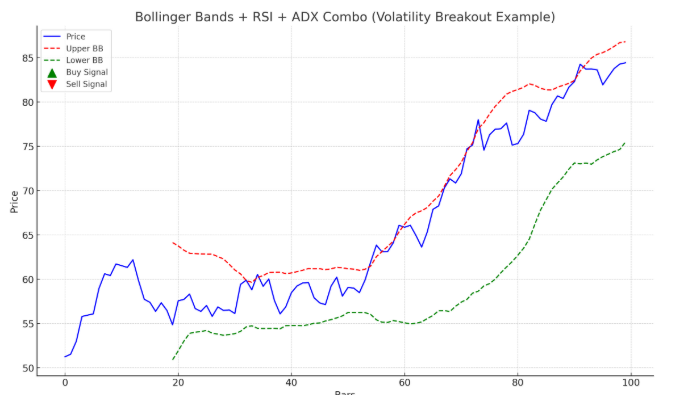Let’s now cover Volatility Indicators — these measure the rate and magnitude of price movement (how much the market fluctuates), helping traders detect breakout opportunities, risk levels, and when a trend might pause or reverse.
⚡ Volatility Indicators (Types + Use Cases)
1. Bollinger Bands (BB)
- Type: Volatility Bands
- How it works:
- Based on a 20-period SMA with upper/lower bands set at ±2 standard deviations.
- Bands expand = higher volatility, Bands contract = lower volatility (squeeze).
- Use Case:
- Detect breakouts after a squeeze.
- Identify overbought (near upper band) and oversold (near lower band) conditions.
2. Average True Range (ATR)
- Type: Volatility Measure
- How it works:
- Calculates the average range between high and low over a set period (usually 14).
- Higher ATR = more volatility.
- Use Case:
- Set stop-loss levels (e.g., 2 × ATR).
- Filter markets: avoid low ATR ranges if you want strong moves.
3. Keltner Channels
- Type: Volatility Bands
- How it works:
- Channels are based on EMA + ATR.
- Narrow channels = low volatility, Wide channels = high volatility.
- Use Case:
- Spot trend continuation or breakout when price closes outside the channel.
4. Donchian Channels
- Type: High/Low Channel
- How it works:
- Upper band = highest high of last N periods.
- Lower band = lowest low of last N periods.
- Use Case:
- Breakout strategy (buy on breakout above, sell on breakdown below).
- Widely used in Turtle Trading Strategy.
5. Chaikin Volatility Indicator
- Type: Volatility Oscillator
- How it works:
- Measures the difference between high and low prices over time, adjusted by EMA.
- Rising values = increasing volatility, Falling = decreasing volatility.
- Use Case:
- Anticipate price breakouts or consolidations.
6. Historical Volatility (HV)
- Type: Statistical Measure
- How it works:
- Uses standard deviation of returns over a specific time frame.
- Use Case:
- Often used in options trading to price risk.
- Compare with Implied Volatility (IV) to find cheap/expensive options.
✅ Summary Table
| Indicator | Type | Best Use |
|---|---|---|
| Bollinger Bands | Volatility Bands | Detect breakouts, overbought/oversold |
| ATR | Volatility Measure | Position sizing, stop-loss placement |
| Keltner Channels | EMA + ATR Bands | Trend continuation & breakout confirmation |
| Donchian Channels | High/Low Bands | Classic breakout trading |
| Chaikin Volatility | Oscillator | Volatility expansion/contraction alerts |
| Historical Volatility | Statistical | Options pricing, risk assessment |
⚡ Pro Tip:
Volatility indicators are best used with trend or momentum indicators. Example:
- Bollinger Band Squeeze + MACD breakout → high probability move.
- ATR-based stop-loss + ADX filter → safer trades.
Perfect 👌 Let’s build Best Volatility Indicator Combinations with ready-to-use trading rules (entry/exit conditions). These setups combine volatility tools with trend/momentum filters so signals are stronger and safer.
🔥 Best Volatility Indicator Combinations
1. Bollinger Bands + RSI + ADX
✅ For Breakouts with Momentum Confirmation
Trading Rules:
- Buy Entry:
- Price closes above upper Bollinger Band.
- RSI > 60 (momentum confirmation).
- ADX > 20 (trend strength filter).
- Sell Entry:
- Price closes below lower Bollinger Band.
- RSI < 40.
- ADX > 20.
- Exit:
- RSI crosses back to neutral (45–55).
- Or opposite band touched.
📌 Works best for strong breakout trades after low volatility squeeze.
2. ATR + Supertrend + MACD
✅ For Trend Trading with Dynamic Stops
Trading Rules:
- Buy Entry:
- Supertrend turns bullish (green).
- MACD line crosses above signal line.
- ATR > average ATR (volatility expansion).
- Sell Entry:
- Supertrend turns bearish (red).
- MACD line crosses below signal line.
- ATR > average ATR.
- Exit / Stop-loss:
- Use 2 × ATR trailing stop.
📌 This is a strong swing-trading setup: ATR ensures you only trade when price is moving enough.
3. Donchian Channels + ADX + CCI
✅ For Turtle-Style Breakout Trading
Trading Rules:
- Buy Entry:
- Price closes above Donchian Channel high (20 periods).
- ADX > 25 (trend strength filter).
- CCI > +100 (bullish momentum).
- Sell Entry:
- Price closes below Donchian Channel low.
- ADX > 25.
- CCI < -100.
- Exit:
- Trail stop using Donchian midline or opposite signal.
📌 Best for medium-term breakout traders (similar to famous Turtle Trading).
4. Keltner Channels + Ichimoku Cloud + RSI
✅ For Trend Continuation & Pullback Trading
Trading Rules:
- Buy Entry:
- Price closes above Keltner upper channel.
- Ichimoku Cloud bullish (price above cloud).
- RSI between 50–70 (healthy uptrend, not overbought).
- Sell Entry:
- Price closes below Keltner lower channel.
- Ichimoku Cloud bearish (price below cloud).
- RSI between 30–50.
- Exit:
- When RSI hits extreme (≥ 80 or ≤ 20).
- Or price closes back inside Keltner channel.
📌 Good for swing traders who ride trend continuation moves.
✅ Quick Comparison Table
| Combo | Best For | Strength |
|---|---|---|
| BB + RSI + ADX | Breakouts | Catches strong momentum moves |
| ATR + Supertrend + MACD | Swing trades | Great for trend + volatility stop-loss |
| Donchian + ADX + CCI | Turtle breakout | Proven strategy for medium-term moves |
| Keltner + Ichimoku + RSI | Trend continuation | Filters fake breakouts with Ichimoku |
⚡ Pro Tip:
- Use BB or Keltner for breakout signals.
- Use ATR for stop-loss & position sizing.
- Use ADX/RSI/CCI to confirm trend strength & momentum.
👉 A visual chart walkthrough showing one of these volatility combos in action with entry/exit markers?

Here’s a visual chart walkthrough of the Bollinger Bands + RSI + ADX volatility breakout setup:
- Blue line → Price
- Red dashed line → Upper Bollinger Band
- Green dashed line → Lower Bollinger Band
- Green ▲ markers → Buy signals (price breaks upper band, RSI > 60, ADX > 20)
- Red ▼ markers → Sell signals (price breaks lower band, RSI < 40, ADX > 20)
This shows how the volatility breakout + momentum filter can highlight strong entry/exit zones.
